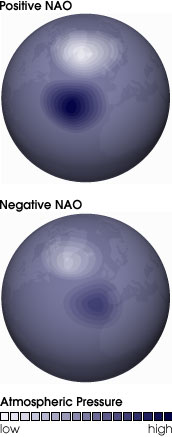North Atlantic oscillation facts for kids
The North Atlantic Oscillation (NAO) is a weather phenomenon in the North Atlantic Ocean of fluctuations in the difference of atmospheric pressure at sea level (SLP) between the Icelandic Low and the Azores High. Through fluctuations in the strength of the Icelandic low and the Azores high, it controls the strength and direction of westerly winds and location of storm tracks across the North Atlantic. It is part of the Arctic oscillation, and varies over time with no particular periodicity.
The NAO was discovered through several studies in the late 19th and early 20th centuries. Unlike the El Niño-Southern Oscillation phenomenon in the Pacific Ocean, the NAO is a largely atmospheric mode. It is one of the most important manifestations of climate fluctuations in the North Atlantic and surrounding humid climates.
The North Atlantic Oscillation is closely related to the Arctic oscillation (AO) (or Northern Annular Mode (NAM)), but should not be confused with the Atlantic Multidecadal Oscillation (AMO).
See also
 In Spanish: Oscilación del Atlántico Norte para niños
In Spanish: Oscilación del Atlántico Norte para niños


